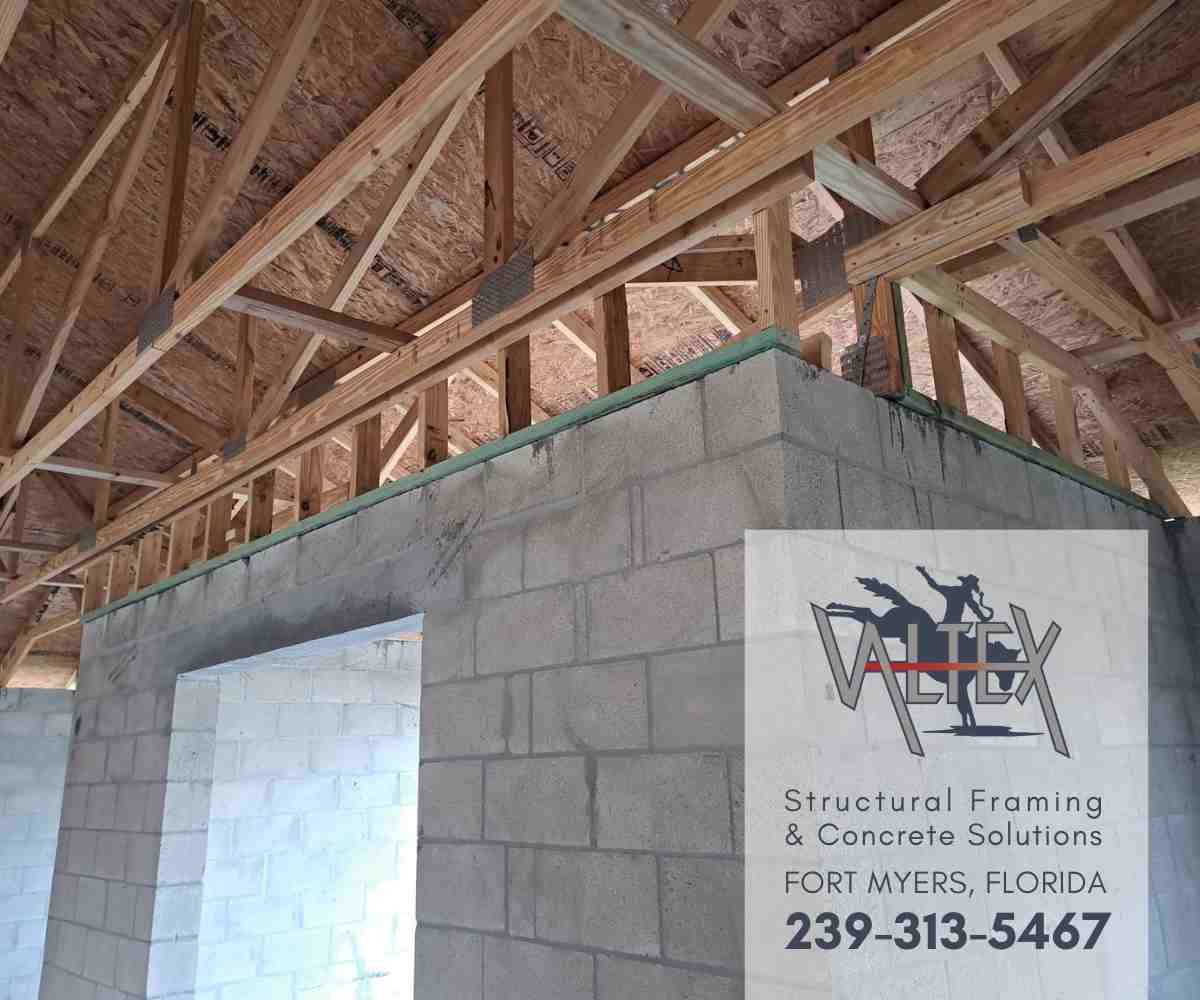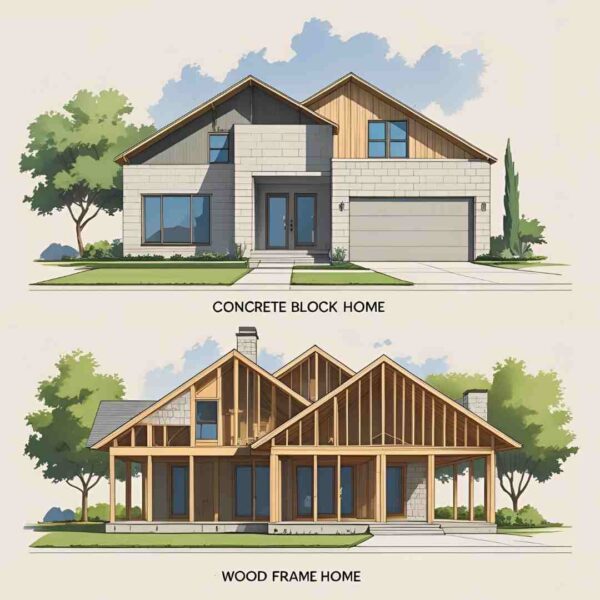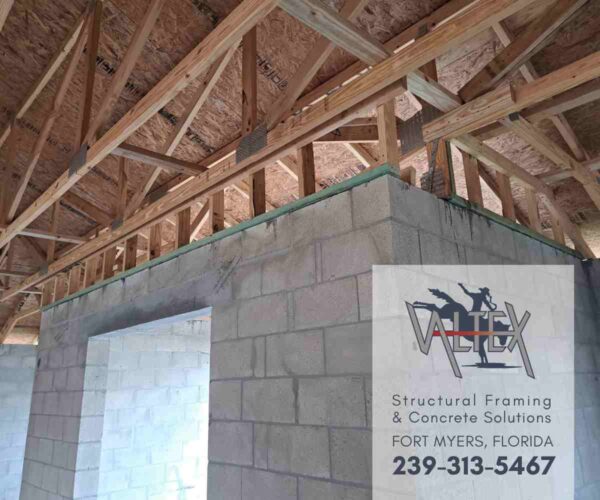
We get asked this all the time: what's better, a concrete block vs wood frame construction in Florida? And the truth is, there's no one-size-fits-all answer. It really depends on your budget, location, and what kind of risks you're trying to protect against—like hurricanes, termites, or rising insurance premiums.
As a structural concrete contractor, Valtex works primarily on commercial and multifamily buildings, but we occasionally get called in for residential corrective work—like failed foundations or structural CMU wall issues. While we don’t build wood frame homes, we understand this topic is important to Florida homeowners and builders alike. The purpose of this article is to help educate, especially our SW Florida friends, on the key differences between concrete block and wood frame construction.
Let's break down the differences in plain terms, based on what really matters to Florida homeowners: cost, durability, storm safety, energy efficiency, and practicality.

Comparison Overview - Concrete Block vs Wood Frame
Let’s take a look at how these two construction methods compare in the real world.
Material Characteristics
Material properties are the foundation—literally—for how well your home stands up to Florida's climate.
- Concrete block (CMU) is solid, fireproof, and doesn’t attract termites or mold. It’s great for sound and moisture insulation but isn’t the best at keeping cool air in without added insulation.
- Wood framing is easier to work with, great for design flexibility, and naturally insulates better. But it’s also more vulnerable to Florida’s humidity and pests unless properly treated.
Common Uses in Florida Homes
Depending on where you're building, you'll often see different materials used strategically.
- Concrete block is typically used for the ground floor or entire structure in high-risk areas. It’s the go-to for homes that need to meet strict wind-load standards.
- Wood framing is common in second stories and interior walls. Inland homes often use wood framing exclusively to keep costs down.
Concrete Block vs Wood Frame Cost Comparison
Let’s talk money—because upfront cost is often the biggest deciding factor.
While concrete block construction typically costs more at the start, those added dollars can come back to you in other ways: better storm performance, fewer maintenance headaches, and lower insurance premiums. Wood frame homes tend to be cheaper to build, which is why they’re more common inland or on tighter budgets. But the long-term costs—repairs, pest treatment, storm prep—can even things out over time.
- Upfront costs: Building with concrete block can run $200–$400 per square foot. Wood is typically cheaper up front, particularly in areas with more relaxed codes.
- Long-term costs: Concrete block might cost more to build, but it could save you in the long run with fewer repairs, better storm protection, and insurance discounts.
Insurance and Energy Efficiency
Homeowners in Florida are very familiar with two big-ticket items: insurance and energy bills.
- Insurance: Many insurance companies reward concrete block homes with lower premiums because they handle wind, water, and fire damage better.
- Energy: Wood-framed homes insulate better from the start. Concrete block homes need added insulation but offer thermal mass benefits—great for keeping temps stable.
Concrete Block vs Wood Frame - Structural Considerations
Florida’s storms and heat put homes to the test.
- Durability: Concrete block homes can last 50–100 years and are resistant to mold, termites, and flooding.
- Maintenance: Wood homes tend to need more TLC—like pest treatments, moisture control, and regular repainting or sealing.

Climate Resilience and Environmental Impact
Storm protection and sustainability both factor into the building decision.
- Hurricane strength: Concrete block homes hold up better in high winds. Masonry construction is often required in coastal zones.
- Eco impact: Wood is renewable and has a lower carbon footprint. Concrete is more carbon-intensive, though green tech is improving this.
Florida’s climate also demands that homes adapt to high humidity, salt air, and extreme heat. Concrete block construction has the edge in resisting moisture and storm impact, while wood offers a renewable alternative with lower energy use in manufacturing. That said, both materials are adapting: new methods of carbon-capturing concrete and sustainably sourced lumber are making it easier to build greener, no matter the method. With smart planning and material choices, it’s possible to create energy-efficient homes that are tough enough for Florida’s climate and mindful of long-term environmental impact.
Maintenance and Pest Resistance
Keeping your home in shape in Florida’s humid, subtropical climate requires consistent maintenance. Material choice plays a big role in how much time—and money—you’ll spend over the years.
- Concrete block keeps bugs and rot at bay. Repairs are usually cosmetic—like touching up paint or sealing mortar joints.
- Wood framing needs more frequent maintenance, especially to combat Florida’s moisture and insects.
Insulation and R-Value - Concrete Block vs Wood Frame
When people talk about energy efficiency in construction, one of the first terms that comes up is R-value — it measures how well a material resists heat flow. In simple terms: the higher the R-value, the better your walls and roof are at keeping cool air in (and hot, humid Florida air out).
Here's how the concrete vs. wood frame builds stack up on insulation:
- Concrete block needs extra insulation to meet energy codes—typically rigid foam or insulated panels—since it has a low R-value on its own.
- Wood frame walls are naturally better insulators and easier to air seal, making it simpler to hit energy efficiency targets.
Safety and Code Compliance
Meeting Florida’s strict building codes isn’t optional—it’s essential to protect your investment and meet insurance and legal requirements. Building materials must stand up to high wind speeds, moisture, and fire hazards.
- Concrete block generally exceeds fire and wind resistance standards.
- Wood frame homes can meet codes with added bracing, impact-rated materials, and hurricane connectors.
Construction Speed and Labor
The speed of construction can also influence your decision—especially when trying to meet deadlines or budget constraints.
- Concrete block takes more time and requires skilled labor. Rain can cause delays.
- Wood framing goes up quicker and has more available labor, especially with prefabricated components.
Concrete Block vs Wood Frame - So, Which Is Better?
Which is better? That depends. If you’re building near the coast or in a hurricane zone and want max protection, concrete block is tough to beat. If you're inland and budget-conscious, wood framing can be an option—especially with modern building upgrades.
Either way, Florida’s strict codes ensure you can build a strong, safe home.
